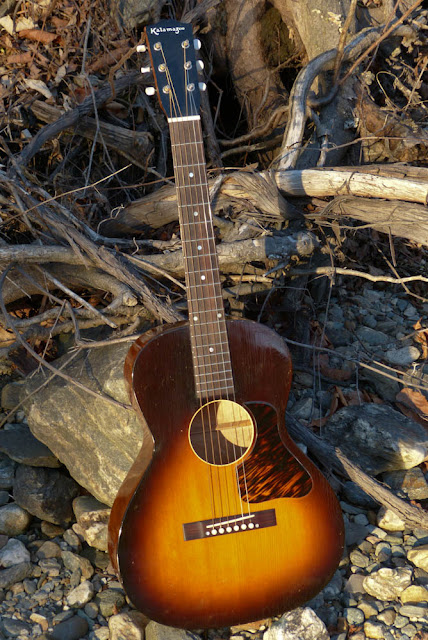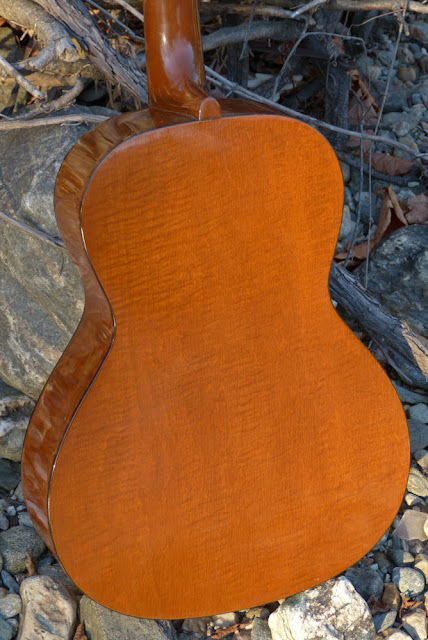1942 Gibson-made Kalamazoo KHGN-12 Flattop Guitar
This guitar has lived a double-life: it was born a "Hawaiian" guitar (raised nut and strings for lap play) and, sometime recently, converted over to a "Spanish" guitar (held and played as normal). I'd recently worked on a KHG-14 and so when a consignor told me this was on its way I sort-of knew what lusty sounds I was in for, but I didn't expect it to be as cool as it turned out to be. Very few of this particular model were made as they came late in the game for Hawaiians: this one has an H-suffix factory order number which places it right around 1942.
I'm guessing, from the build (spruce over laminate flamed maple and tortoise binding), that this would've been labeled a KHGN-12 when made... a 12-fret Hawaiian version of the KGN-12 "Oriole" which was basically a natural-top, maple back/sides KG-12 variant -- the KG-12 simply being the late-30s/early-40s version of the trusty KG-14. You can read-up all you want on these model changes at the inestimable Fox Guitars page on Gibon's obscure makes. The issue with that classification, however, is that the top on this was most certainly done-up in a sunburst and has no "Oriole" label which suggests it's more like an alternate version of the "normal" KG-12 instead.
Whatever it's model designation, the important part is that these 12-fret variants of the KG-14 body sound tremendous. Lowering the bridge on the ladder-braced body bulks-up the lower-mids response and truly makes these guitars a decent competitor tone-wise (from a flatpicking point of view) with the x-braced L-00s and whatnot bearing the Gibson branding. These are gutsy, loud, and fun guitars to jam on. The best bit is that they also make hot fingerpickers, too, as they feature a lot of that sing-songy, open tonality that the 14-fret KG-14 bodies have in spades.
Much work was done on this guitar before I got it in the shop, however. It has repro (StewMac Golden Era) tuners, a bespoke custom, low-profile bridge installed, a new Tusq saddle and "ivoroid" StewMac pins, and the fretboard appears to have been planed and refretted. To top it all off I'm not sure but am fairly certain that the entire instrument has had the very lightest of oversprays -- done in nitro -- with all of the old weather-check peeping-through to keep it honest. The nut was also replaced with a beautifully-made bone one. It's a looker in-person.
The only bit I had to do when it arrived was give it string ramps at the bridge, B-string intonation and height adjustment at the saddle, and a good general setup. It plays great -- standard 3/32" EA and 1/16" DGBE at the 12th fret with a set of 12s installed and a good, straight neck.
Let's talk woods, quickly: the top is solid spruce, the neck is mahogany, the board is Brazilian rosewood, the replacement bridge is Indian rosewood, and the back and sides are laminate flamed maple. Gibson was using the latter on quite a few instruments by the early 40s as the look was in vogue at the time.
The nut is a full 1 15/16" in width. The board has a light radius and the neck profile is C-shaped. It's quite comfortable to play and the wide spacing makes those bluesy fingerpicked cowboy chords really easy to keep clean.
Pearl dots, of course.
Firestripe pickguard -- I know, right? Looks great.
The bridge was expertly-made. Note the fancy StewMac repro-style bridge pins and 40s-Gibson-style pearl dots near the bridge wings. The factory neck angle wasn't fussed-with when the work was done to it, but it also wasn't necessary to do so. This guitar plays excellently-well and has a bit of adjustment room left at the saddle if need be.
I'm a sucker for tortoise binding.
Not only does that maple look good, the laminate back/sides means these 40s Gibsons are often a bit more stable, too, over time -- and they certainly contribute a "maple" flavor to the tone vs. the slightly-more-honky "hog" tone I'm used to on Kalamazoos.
StewMac "Golden Era" tuners are a nice inclusion.
The endpin appears original.
A (presumably) original brown chip case comes with the guitar, too, and has been well-kept.
I'm guessing that this may have been owned by a young Mr. Wilber, judging by this census. Here's another info link. Considering Hazelton is only 2 hours away from Kalamazoo by car, that may mean it didn't have to go too far to find its first owner.



















Comments
a great resource for collector/hoarders.
Herb